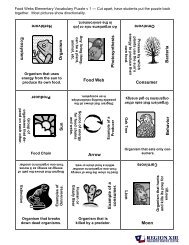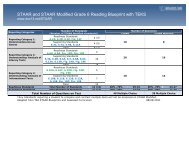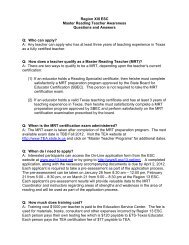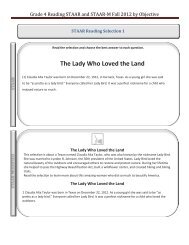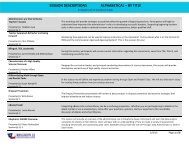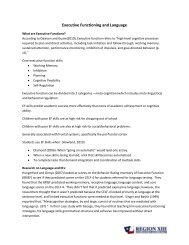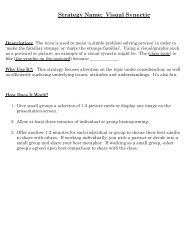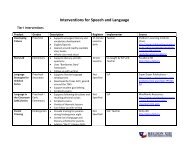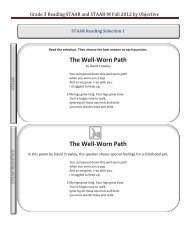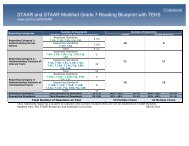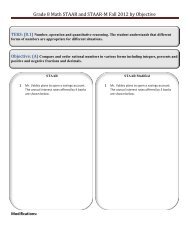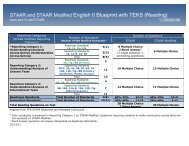2nd Six Weeks Newsletter - Region 13
2nd Six Weeks Newsletter - Region 13
2nd Six Weeks Newsletter - Region 13
You also want an ePaper? Increase the reach of your titles
YUMPU automatically turns print PDFs into web optimized ePapers that Google loves.
Scientific InvestigationsThe world of science has changed for the teachers ofTexas. The Texas Education Agency (TEA) has declaredthe focus for the new Science TEKS as “fewer,clearer, and deeper.” The new specificity was introducedto teachers during the summer TEKS professionaldevelopment academies. One area that has undergonechange is that of scientific investigations. Inthe past, the scientific method was taught to studentsas a step-by-step process and all experiments had thesame basic criteria. In fact, Sandra West (2010) sharesa powerful message, statingI first encountered the widespread misconceptionabout “The Scientific Method” in1982 when one of my 9 th grade honors biologystudents was working with a local scientiststudying freshwater crustaceans. Thestudent discovered a new species that wasconfirmed by an invertebrate zoologist. Thiswas the student’s science fair research project.He was penalized 10 points for nothaving a “control.” When the judge wasquestioned about the penalty, she was noteven aware of the descriptive scientific researchdesign.Many excellent teachers of science fall into this samecategory and so with the new changes in the scienceTEKS comes a new opportunity to look at our sciencelessons to verify accurate content, review the new rigorof the new TEKS, and, in the case of scientific investigations,revise and/or create appropriate materials andinvestigations to prepare our students for success.Oftentimes we ask students to make observations inscience class. We ask them to draw diagrams, describecharacteristics of objects/organisms, and make quantitativeobservations. If you have done this in your scienceclass, you have conducted a descriptive investigation.In fact, this is truly the first step in real worldscience. “Descriptive investigations involve collectingqualitative and/or quantitative data to draw conclusionsabout a natural or man-made system (e.g., rock formation,animal behavior, cloud, bicycle, electrical circuit).A descriptive investigation includes a question, but nohypothesis. Observations are recorded, but no comparisonsare made and no variables are manipulated.” (Texas EducationAgency, 2010)In a comparative investigation, as the name suggests, studentsare asked to compare two or more objects. However, itis here where educators can be confused. The Texas EducationAgency (2010) clarifies this by defining comparative investigationas involving “collecting data on different organisms/objects/features/events, or collecting data under differentconditions (e.g., time of year, air temperature, location) tomake a comparison. The hypothesis identifies one independent(manipulated) variable and one dependent (responding)variable. A ‘fair test’ can be designed to measure variables sothat the relationship between them is determined.” Most ofthose “experiments” or “labs” students do in class have beencomparative investigations. When students recorded the distancea cart travels down a ramp at different heights, a comparativeinvestigation is being conducted. Yes, students keepthe inclined plane the same, the cart the same, and use thesame type of measuring device; however, there was not acontrol group with which the independent variable was notapplied. Students were just comparing the different rampheights and looking for a relationship, whereas in our thirdand final investigation the goal is to determine “cause andeffect.”The distinguishing characteristic of the third and final type ofinvestigation is the presence of a control group for which theindependent variable is not applied. Experimental investigationsinvolve designing a “fair test” similar to a comparativeinvestigation, but a control is identified. The variables aremeasured in an effort to gather evidence to support or notsupport a causal relationship. This is often called a “controlledexperiment.”TEA has provided a “clearer and deeper” expectation for ourstudents. In order to aid in this transition, consider the following.In a science class, use the word investigation rather thanlab or experiment. When labeling variables that stay the samein both the comparative and experimental investigations, usethe term constant. (In the above example, the constantswould have been the inclined plane, the cart, and the measur-Investigation type Purpose Hypothesis? Variables manipulated?Control?Descriptive To draw conclusions No. Answers a question.NoNoComparative To determine relationshipsYes Yes NoExperimental To determine presenceYes Yes Yesor absence ofcausality(Source: Texas Education Agency, 2010)5



